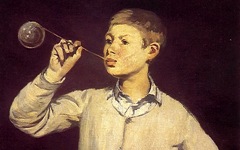Manet’s Execution of Emperor Maximillian (1867-8)
Art scholars have sometimes wondered why the execution squad in Manet's Execution of Emperor Maximillian (1867-8) are so unrealistically close to their target. Indeed, on close inspection, their rifles are aimed as though they would miss. To those aware of the underlying level, the reason is clear: the rifles are "brushes" painting their target which is why they actually "touch" it. The billowing smoke from the "brushes" is a traditional symbol of the imagination.

Manet's Execution of Emperor Maximillian (1867-8) Oil on canvas. Mannheim Kunsthalle.
Click image to enlarge.
The meditative officer on the right cocks his rifle even though his men have already fired, another visual inconsistency. He is an “artist” too, posed like a painter. His right hand with its thumb stretched is reminiscent of how a painter stretches his thumb to hold a palette while his other arm, like an artist’s, is poised over the unseen palette. His rifle, similar to the giant sword in Manet’s Boy with a Sword, is a metamorphic “paintbrush” loaded with symbolism.
See conclusion below
The soldiers as a group execute Manet’s painting of three Mexicans. Manet intended the pun because he presents them facing the canvas as he did. All three men about to die represent Manet too because every painter paints himself. In support, each of their real names began with M like Manet’s and their legs form an M as well.
Click next thumbnail to continue

L: Detail of Emperor from Manet's Execution of Emperor Maximilian (1867-8)
R: Detail of Manet's Self-portrait, inverted (1878-9)
Click image to enlarge.
The depiction of the Emperor in the middle, moreover, is a close resemblance of Manet himself as scholars have often noted without knowing why. See comparison at left.
Click next thumbnail to continue
The halo-like sombrero of the Emperor in the middle of a Trinity facing death suggests a great artist’s traditional Christomorphism despite Manet’s own lack of religious interest. As long noted with amazement, they have signs of stigmata on their hands even before, it would seem, the rifles had fired. Death is, moreover, a common metaphor in art for the completion of a painting as the spectators acknowledge in part by looking over the wall to marvel at Manet’s most recent achievement.
See conclusion below
Lastly, the Mexican rebels shooting the Emperor are inappropriately dressed in uniforms reminiscent of the French military. Cultural historians have suggested that Manet is here criticizing French foreign policy when what he is really doing is symbolizing the squad as a great “French artist”, Edouard Manet.
More Works by Manet
See how both Manet and Chardin veil their meaning in the same way

Manet’s and Chardin’s Soap Bubbles (18th/19th Cent.)
Notes:
Original Publication Date on EPPH: 20 Apr 2010. | Updated: 0. © Simon Abrahams. Articles on this site are the copyright of Simon Abrahams. To use copyrighted material in print or other media for purposes beyond 'fair use', you must obtain permission from the copyright owner. Websites may link to this page without permission (please do) but may not reproduce the material on their own site without crediting Simon Abrahams and EPPH.



